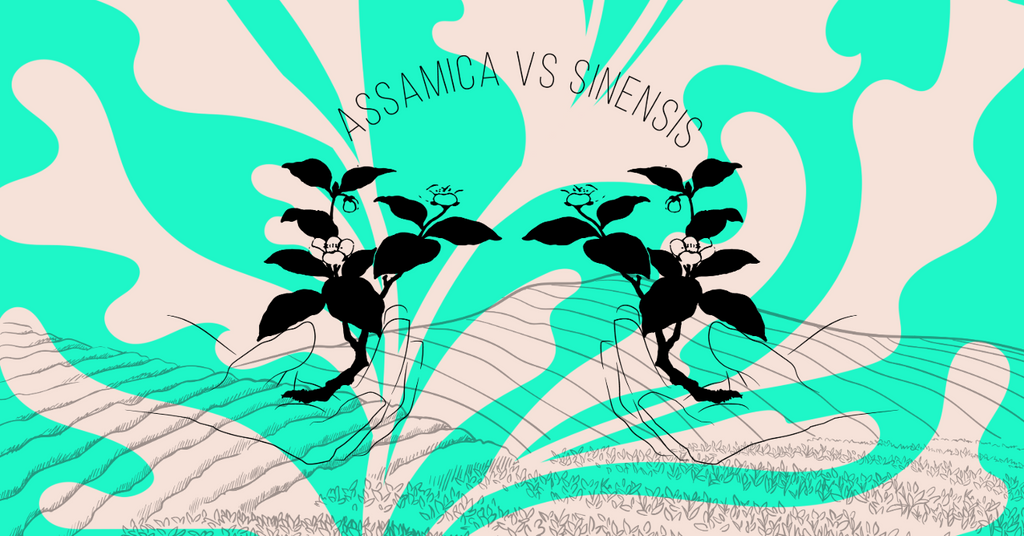Sinensis Vs. Assamica

I never cease to be amazed that all true tea originates from one plant: Camellia sinensis. Commonly known as the tea plant, it encompasses all black, green, white, oolong, puer, and yellow tea categories. Two main varietals are most commonly grown: the high-elevation Camellia sinensis var. sinensis (China bush), known for sweet, complex flavors while the low-elevation, and the high-yielding Camellia sinensis var. assamica (Assam bush) delivers a bold, strong flavor suitable for milk and sugar. Both can create a range of tea styles, from lowest to highest quality.
In addition to these two, you may have also heard of Camellia sinensis var. cambodi (Java bush): the plant of choice for more tropical, rugged regions mostly in Southeast Asia (especially Indonesia)—though due to a much less dependable yield than the Assam bush and the need for more specific environmental conditions, it remains lower on the Camellia sinensis propagation ladder.
And just to make things a little more complicated, there’s Camellia taliensis (that I very recently learned about from Tea, A Nerd’s Eye View by Virginia Utermohlen Lovelace), a wild form of camellia which is now semi-cultivated. Historically, it's been used locally in Yunnan to make puer, and is gradually becoming available internationally in limited quantities.
It's important to note that since the tea plant has been around for many millennia, it's extremely hard to find the "pure" form of the main varietals in our timeline; so nowadays, they'd be more accurately described as sinensis-leaning, or assamica-leaning. In addition, the above genera have many subdivisions and more than a thousand subvarieties. So, to keep our nerding out within reason, I am going to stay focused on the very high-level differences between var. sinensis and var. assamica. Let's dive in!
Sinensis Vs. Assamica: What Sets Them Apart
Habitat + Terroir
- Camellia sinensis var. sinensis: Originating from China, it thrives in cool, higher-altitude, and mountainous regions, ideally with a southern exposure (elevations of 6,500 to 9,800 ft or 2,000 to 3,000 meters). Main propagation regions: China, Japan, Taiwan, some areas of Southeast Asia, and the Himalayas (notably Darjeeling).
- Camellia sinensis var. assamica: This variety is native to the Assam region of India and thrives in warm, jungle-like, and lower-altitude areas. It loves high humidity and rainfall of 100 inches (254 centimeters a year) and average temperatures of 85 F (29 c). If the topography allows for these conditions, the tea can grow equally well above 6,500 ft (2,000 meters) as well as in the flat, lower-altitude Assam valley. Main propagation regions: Assam and northeastern India, Sri Lanka, and most of Africa.
Botanical Look + Dimensions
- Camellia sinensis var. sinensis: Tender, small, delicate leaf and appearance. Young leaves are light green and resemble elliptical blades, presenting the well-known profile of two leaves and a bud. Mature leaves are deep green, leathery yet smooth, with serrated, feathery edges, and are about 4-10 cm (1.5-4 in) long and 1.5 cm (0.5 in) wide. It grows as a shrub, 3 to 10 feet (1-3 meters) high, with straight, almost vertical branches that rise from the base of the plant like a reverse cascade. If allowed to grow freely, it develops a domed shape which is why it’s pruned flat to create a plucking table for new growths.
- Camellia sinensis var. assamica: Resembling a small tree rather than a bush, it can attain heights of 35-50 ft (10-15 meters) if allowed to grow freely. It’s supported by a distinct trunk and a ramifying branch system. The leaves of this variety are larger, broadly elliptical, and more robust compared to sinensis. They are glossy with distinct marginal veining and can be in the range of about 7-22 cm (2.5-8.5 in) long and 3-8 cm (1-3 in) wide. The plant has a natural tendency to grow taller and less rounded, which needs to be plucked differently than the China bush.
Growing Season + Yield
- Camellia sinensis var. sinensis: Short plucking season, with no more than 4-5 plucks a year.
- Camellia sinensis var. assamica: In its ideal subtropical and tropical conditions, it can be picked as often as every 10 days, year-round.

Resilience
- Camellia sinensis var. sinensis: This variety is generally more sensitive to extreme temperature variations and pests, though tolerant of frost.
- Camellia sinensis var. assamica: Assamica plants are typically more resilient, disease-resistant, and adaptable to various environmental conditions, making them suitable for cultivation in a wider range of regions. Being used to a tropical habitat, assamica has to survive more competition in the natural world, which is why it can withstand more environmental attacks.
Flavor Profile (What This All Means To The Cup Experience)
- Camellia sinensis var. sinensis: Nuanced. Known for producing teas with delicate, layered flavors and less tannin content. Teas made from var. sinensis tend to have floral, fruity, and sometimes sweet notes. On the flip side, this can sometimes make a weaker brew. Generally associated with higher quality cups, adding milk, sugar or spices subtracts from the experience.
- Camellia sinensis var. assamica: Punchy. Assamica teas are often stronger, bolder, darker, more astringent and full-bodied. This robustness lends itself well to the addition of milk and sugar (such as Chai, for example), though it can produce some interesting and delicious results in other styles as well. When grown in Assam—its namesake habitat—it’s known for its sought-after malty qualities. Veteran cuppers say that this quality is in decline due to a mix of climate change and shifting production styles.
Caffeine Content
There is not enough data to definitively show consistent differences between the two varietals. Generally, it’s safe to consider that both contain similar levels of caffeine. Read our blog “Is Tea High In Caffeine?” to go more deeply into this hotly discussed topic!
While these are the primary differences between the two varietals, factors such as cultivar, terroir, and processing methods continue to stretch the limits of the plant and the brew that ends up in our cups. One of the many reasons why when you enter the tea world, the journey never ends!
Want to compare classic teas made with sinensis & assamica?
Drink Darjeeling Green & Assam Black
You might also enjoy:
Blog Author:

Mitra Nite, Design & Marketing
Growing up in Persia, tea runs in Mitra's blood. But it was while living and working in the Pacific Northwest that she truly found herself immersed in the beverage and all its delicious forms, and she continues to be delighted by the international and cultural nuances that it represents. Mitra has been active as an artist and designer for most of her adult life, and is very happy to bring her passion for tea and design to Young Mountain Tea.






Leave a comment